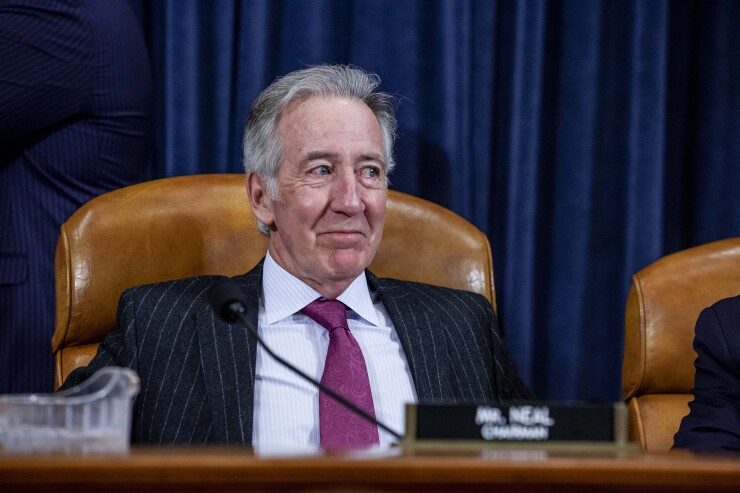WASHINGTON -- Municipal bond market advocates this week asked House lawmakers who are crafting the tax policies for infrastructure legislation to bring back advance refundings, expand private activity bonds and restore direct-pay bonds that would be similar to Build America Bonds.
The groups also want small issuers and borrowers to receive bank-qualified loans of up to $30 million instead of the current $10 million limit and to apply that limit to the borrower instead of the issuer. The BQ limit was last raised in 2009, along with the creation of BABs, in the stimulus package, but both provisions expired at the end of 2010.
“Banks have increasingly become important lenders to local units of government, and reducing the expense of lending will encourage local government infrastructure financing,” the National Association of Bond Lawyers said in comments filed with the House Ways and Means Committee on Wednesday.
NABL also suggested expanding PABs for a new category that includes public roads, tunnels, and bridges.
The new PABs should include “functionally related improvements, such as entrance and exit ramps, overpasses, turnouts, public parking areas, public restroom facilities, drainage, landscaping, lighting and signage” not related to commercial advertising, NABL said.
The Public Finance Network and the American Public Power Association also submitted comments Wednesday, which was the deadline for groups that didn’t testify at a March 6 hearing to offer their suggestions.
That hearing, headlined as “Our nation’s crumbling infrastructure and the need for immediate action,” included recommendations from Gregory DiLoreto, a past president of the America Society of Civil Engineers for focusing on the use of tax-exempt municipal bonds and restoring advance refundings as financing tools.
DiLoreto included that as one of his four top infrastructure financing priorities. The other three were funding the Highway Trust Fund, increasing the cap on the Passenger Facility Charge to modernize airports, and ensuring all funds in the Harbor Maintenance Trust Fund are used.

Ways and Means Committee Chairman Richard Neal, D-Mass., said at the end of the four-hour hearing, “I sensed in the room no hostility to the points that were being made.”
That’s encouraging news for the municipal bond market which suffered a significant setback under the December 2017 Tax Cuts and Jobs Act that terminated advance refundings.
Restoring advance refunding is also on the checklists of recommendations from NABL, APPA and the Public Finance Network, which is an umbrella alliance of 26 national organizations. Members of the network that signed the letter include the Government Finance Officers Association, National Association of Counties, National League of Cities and U.S. Conference of Mayors.
APPA said it “strongly supports reinstating advance refunding bonds because it would allow states and localities to refinance existing debt with the greatest flexibility, resulting in substantial reductions in borrowing costs.”
NABL said: “The elimination of tax-exempt advance refundings by the 2017 tax act has imposed substantial financial costs on states and local governments. Use of this financial tool has saved state and local governments billions of dollars in the past, allowing them to provide more comprehensive services, including infrastructure projects, at a lower cost to their citizens.”
The NABL letter offered six recommendations. In addition to restoring advance refundings and an expansion of PABs, NABL suggested a direct-pay alternative to tax-exempt financing similar to Build America Bonds; an increase in the dollar limits for bank-qualified bonds; additional volume cap for tax-exempt PABs; and elimination of the unrelated or disproportionate component of the private business use test and the dollar limits on private business use.
NABL spoke of the success of direct-pay bonds under the Build America Bonds program.
“From April 2009 to December 2010, more than $185 billion in direct-pay Build America Bonds were issued, even though the purposes for which these bonds could be issued were narrower than for traditional tax-exempt bonds,” NABL said. “Underlying the success of the bonds was that the investor base was expanded to include entities that would not be interested in tax-exempt bonds because they are not subject to federal income tax, such as endowment funds, pension funds, and foreign investors. The competition among these additional investors lowered the costs of the infrastructure financed with the bonds – both to the issuers of the bonds and to the federal government.”
The Public Finance Network letter reminded lawmakers to not jeopardize the tax-exemption.
“By issuing tax-exempt debt rather than taxable debt, tens of thousands of governments have saved billions of dollars over the years,” the Public Finance Network letter said. “Without these savings, citizens would see a reduction in the infrastructure that state and local government provide or a direct increase in their taxes and rates in order to make debt service payments.”





